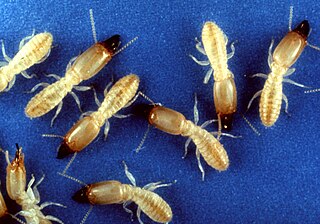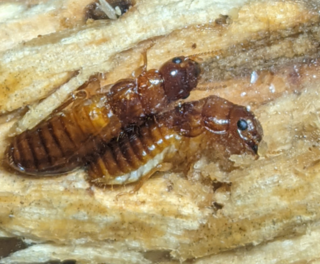
Termites are a group of detritophagous eusocial insects which consume a wide variety of decaying plant material, generally in the form of wood, leaf litter, and soil humus. They are distinguished by their moniliform antennae and the soft-bodied and often unpigmented worker caste for which they have been commonly termed "white ants"; however, they are not ants, to which they are distantly related. About 2,972 extant species are currently described, 2,105 of which are members of the family Termitidae.

The Formosan termite is a species of termite local to southern China and introduced to Taiwan, Japan, South Africa, Sri Lanka, Hawaii, and the continental United States.

Reticulitermes flavipes, the eastern subterranean termite, is the most common termite found in North America. These termites are the most economically important wood destroying insects in the United States and are classified as pests. They feed on cellulose material such as the structural wood in buildings, wooden fixtures, paper, books, and cotton. A mature colony can range from 20,000 workers to as high as 5 million workers and the primary queen of the colony lays 5,000 to 10,000 eggs per year to add to this total.

Trichonympha is a genus of single-celled, anaerobic parabasalids of the order Hypermastigia that is found exclusively in the hindgut of lower termites and wood roaches. Trichonympha’s bell shape and thousands of flagella make it an easily recognizable cell. The symbiosis between lower termites/wood roaches and Trichonympha is highly beneficial to both parties: Trichonympha helps its host digest cellulose and in return receives a constant supply of food and shelter. Trichonympha also has a variety of bacterial symbionts that are involved in sugar metabolism and nitrogen fixation.

Kalotermitidae is a family of termites, commonly known as drywood termites. Kalotermitidae includes 21 genera and 419 species. The family has a cosmopolitan circumtropical distribution, and is found in functionally arid environments.
Calcaritermes is a genus of termites in the Kalotermitidae family.

Cryptotermes is a genus of termites in the family Kalotermitidae. It is one of the economically most significant genera of drywood termites.

Incisitermes is a genus of termites in the family Kalotermitidae.

Incisitermes minor is a species of termite in the family Kalotermitidae known commonly as the western drywood termite. It is native to western North America, including the western United States and northern Mexico. It has been found in many other parts of the United States, all the way to the East Coast. It has been reported from Toronto. It has been introduced to Hawaii. It has been noted in China and it is not uncommon in Japan. This is an economically important pest of wooden structures, including houses. In California and Arizona alone its economic impact is estimated to be about $250 million per year.

Amitermes is a genus of termites in the family Termitidae. Species are found in a range of habitats including deserts and rainforests. Characteristics of Amitermes soldiers include a bulbous head, sickle-shaped mandibles with a single tooth on their inner margins and cephalic glands on the front of their heads.
Glyptotermes ceylonicus, is a species of damp wood termite of the genus Glyptotermes. It is endemic to high elevations Sri Lanka. It is a pest of dead and decaying wood of Hevea, Theobroma, Ficus, and Acacia species.
The Low-country tea termite,, also known as Low country live wood termite, is a species of damp wood termite of the genus Glyptotermes. It is endemic to high elevations Sri Lanka. It is a major pest of tea in low country area of Sri Lanka.
Bifiditermes pintoi is a species of damp wood termite of the genus Bifiditermes. It is found in Sri Lanka.
The domestic drywood termite,, is a species of dry wood termite of the genus Cryptotermes. It is native to Malaysia, Borneo, Australia, China and Sri Lanka. It is mainly a house termite and also found in cultivated areas. The presence of this termite can be identified by small heaps of tiny egg-like pellets of excreta. It is a larger termite species, with 3.25-5.90mm in soldiers. It is considered as a minor pest in Australia, but is a serious pest causing wood damage in other parts of the world.
Glyptotermes chiraharitae is a termite species found from Malabar Wildlife Sanctuary, Kerala, India.
Prorhinotermes simplex, the Cuban subterranean termite, is a species of lower termite in the genus Prorhinotermes. It is found in Colombia. Like others in its genus, it is a single-site nesting termite that moves to a new food source when theirs is gone, and it lacks a true worker caste.

Neotermes jouteli is a species of Neotropical termite in the family Kalotermitidae which is native to South Florida and surrounding West Indian nations. N. jouteli is the largest species of termite in Florida with soldiers reaching a maximum length of 13.35 mm and the winged alates around 16.05 mm.

Constrictotermes is a genus of Neotropical higher termites within the subfamily Nasutitermitinae. They form large open-air foraging columns from which they travel to and from their sources of food, similar to the Indomalayan species of processionary termites. Species of this genus commonly build epigeal or arboreal nests and feed on a variety of lichens, rotted woods and mosses.
Rhynchotermes is a genus of Neotropical higher termites within the subfamily Syntermitinae, represented by 8 known species. Species of this genus are known for their soldiers which have highly developed sickle-shaped mandibles and a pronounced frontal tube superficially analogous to the fontanellar guns of true nasute termites. Most species forage above the surface in the open where they primarily feed on forest leaf litter. Nests are subterranean or are shallow and epigeic.







